Original URL: https://www.theregister.com/2013/06/18/review_samsung_galaxy_note_8_tablet/
Samsung Galaxy Note 8: Proof the pen is mightier?
Sammy’s iPad Mini killer has a stylus to stab other rivals too
Posted in Personal Tech, 18th June 2013 09:04 GMT
Review Bewildering. That’s the best word to describe Samsung’s small tablet range. Since the second half of 2010, the Galaxy Tab, Galaxy Tab 8.9, Galaxy Tab 2 7.0, Tab 7.0 Plus and Tab 7.7 blurred one into the other, much to the confusion of the average customer and me.
Thankfully, the Samsung fondleslab now sat on my desk is a Note, not a Tab, the signature difference between the two being the Wacom digitiser-equipped S-Pen stylus. If a tablet has one, it’s a Note. If it hasn’t, then it’s a Tab.
The stylus and name also makes it easy to see where the Note 8.0 sits in the grand scheme of things: slap bang between the Galaxy Note 2 and the Galaxy Note 10.1.
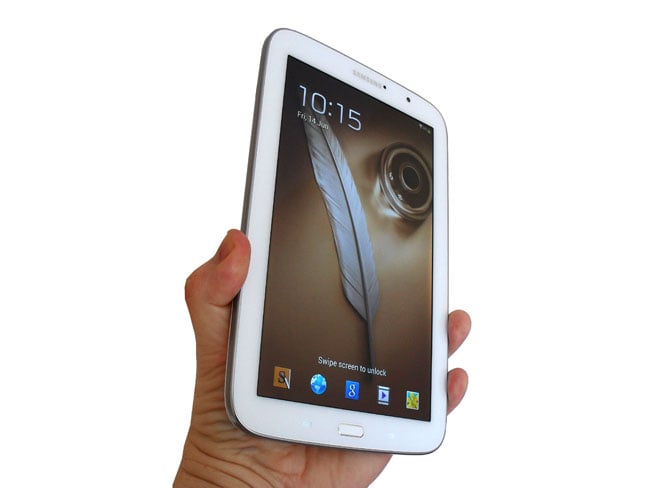
Samsung’s Galaxy Note 8: give it a big hand - it’ll need one
Externally, the Note 8 looks like a pumped-up Note 2 right down to the curvy hyperglaze plastic body and physical home button. And, like the Note 2 and the Galaxy S4, the plastic body makes the Note 8 feel just a little low rent. It’s not as if it pays dividends in the weight department either: at 338g the Note 8 is only 2g lighter than a Google Nexus 7 but 30g heavier than an iPad Mini. But the body doesn’t make fingerprints obvious and it feels very pleasant in the hand.
At 8mm deep and 210.8 x 135.9mm in size, Sammy’s latest tablet isn’t overly portly for an 8-inch device but, again, the iPad Mini is thinner and smaller despite only having a fractionally smaller display. Like the Apple gadget, the Note 8’s battery is fixed in place and the tablet is just a bit too wide to comfortably hold in one hand for a prolonged period.
Name and S-Pen aside, the similarities between the Galaxy Note 8.0 and Note 2 include the chipset, the processor speed, the Android build (4.1.2) and - give or take a few pixels - the screen resolution.
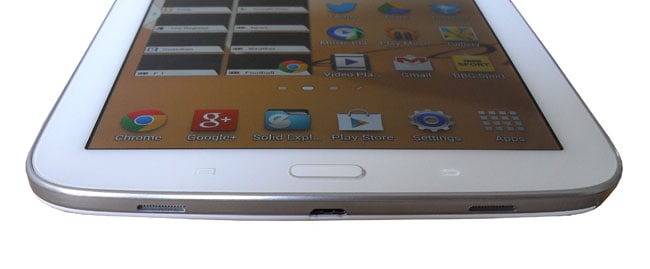
Micro USB and stereo speakers at bottom
You could argue that 1280 x 800 pixels doesn’t quite cut the 8-inch mustard in this day and age. The resulting pixel density is only 189dpi which while better than the iPad Mini’s 162dpi is well short of the Note 2’s 267dpi, or the 216dpi of the Nexus 7. It’s worth clarifying that unlike the rather uninspiring 8-inch Acer Iconia A1 tablet Reg man Tony tested recently, the Note isn’t a 4:3 device but rather a widescreen-friendly 16:10.
In all honesty though, the display looks pretty sharp and crisp, while the screen size and aspect ratio combined with the broadly curved corners and thin top and bottom bezels - well, thinner than the Nexus 7 anyway - make it a very comfortable device to hold in landscape orientation while watching video or playing a game.
As soon as you turn the Note 8 on you’ll notice that the screen is a traditional LCD panel rather than Samsung’s usual Super AMOLED. This means it lacks the Note 2’s eye-catching vividness and super-saturated colours. As tablet screens go, though, it’s a decent enough pudding: bright, colourful and with reasonably good levels of contrast, though its performance in broad daylight was not spectacular.
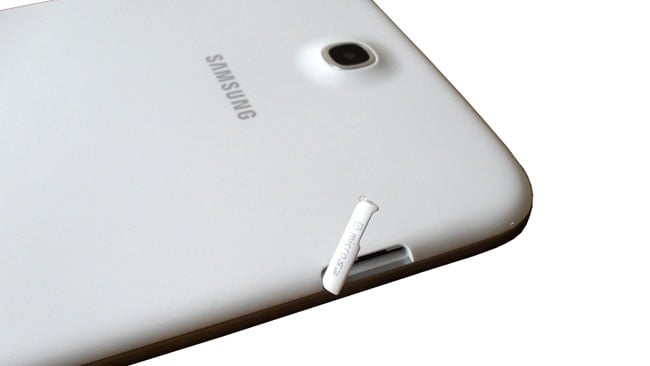
The all-important micro SD card slot
Thanks to sharing the same parts bin as the Note 2, the Note 8 packs an Exynos 4412 quad-core 1.6GHz ARM Cortex-A9 processor, Mali-400MP graphics core, 2GB of RAM, plus GPS and Wi-Fi. Those bits and pieces give it a decent lick of speed, though the Note 8’s AnTuTu benchmark scores can’t match the Galaxy S4’s - 16,800 versus 25,800 - thanks in part to the Mali-400 GPU getting a bit long in the tooth.
That’s not something you need worry about though. All the 3D games I tested on the Note 8 - Real Racing 3, ShadowGun:Deadzone, NOVA 3 - ran perfectly at maximum definition so this really is a case of synthetic benchmark scores highlighting a difference that otherwise you won’t be able to discern.
The Note 8 runs Android under Samsung’s all-pervasive TouchWiz user interface, but that’s OK because TouchWiz makes more sense on tablets that it does on smartphones. The extra screen area makes it look less cartoonish and gives features such as multi-window apps and floating video player more room to breathe. If you really can’t stomach TouchWiz, all the third-party software launchers I tried worked a treat and didn’t mess with any of Samsung’s bespoke baked-in functionality.
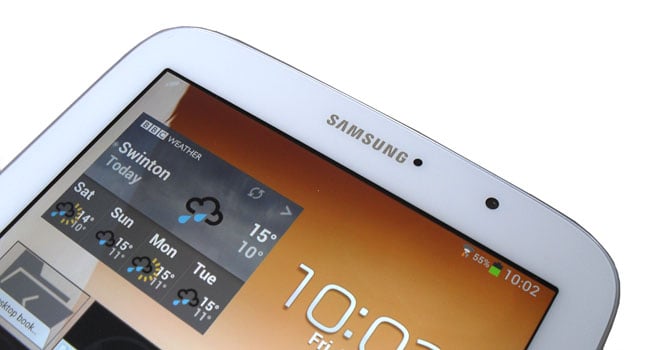
The webcam and the ambient light sensor
In much the same way, the S-Pen also makes more sense when combined with a larger screen. This may have something to do with my wretched handwriting, but the extra space afforded by an 8-inch screen had me reaching for the stylus far more frequently than when I was using the Note 2. The Note 8’s handwriting recognition - toggled directly from the very nice swipe-enabled keyboard - is solid.
As with the Note 2, the oval-profile stylus lives in a slot at the bottom on the device. Slide it out and the Note 8 goes ‘beep’ - thankfully this can be disabled - and a dedicated context menu and home screen automatically opens. The primary apps for S-Pen are S Note, an all-purpose note pad, and Paper Artist, an art app for mucking about with photos. Both are good examples of the breed.
Scribbles for shortcuts: What works, and what doesn't
The stylus can also be used to get stuff done using shortcut scribbles. If you draw an @ with the stylus you open a new email. Draw an ! and Google Maps opens. You can add keywords too, so @ followed by the recipient’s first name opens a new mail to that person, while ! followed by "Salford" will open a map of my ‘hood.
The problem here is that you have to hold the S-Pen’s button down and swipe up on the screen to open the Quick Command window before you start your scribble and then remember to stop pressing the button before you write your command. I found that all a bit of a faff - is writing the letter "C" in Quick Command faster than simply tapping the Chrome icon? Trick question - it’s not.
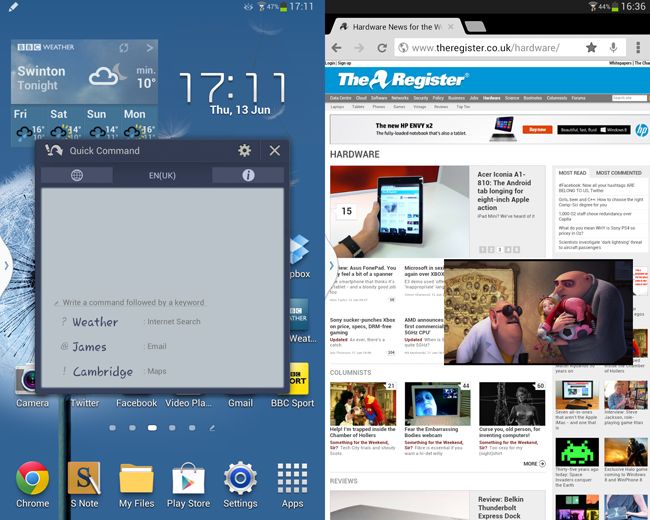
Quick Command (left) is a bit of a faff, but the pop-out video player (right) is a genuinely useful
The usual TouchWiz and S-Pen caveats also still apply. The @ gesture only opens the stock email client, the internet search gesture can’t be set to open Chrome rather than the stock browser, and the S-Pen’s Air View trick only works with Samsung-approved apps. The same is true for apps that can take advantage of the multi-window system.
I could go on and on - and on and on - about all the extras that Samsung adds to Android. I touched on many in my review of the Galaxy S4 and I suspect the features unique to the S4 will roll onto the Note 8 when it gets the upgrade to Android Jelly Bean 4.2. Being a purist, I struggle see the use for many of these features, but they do ladle on what the marketing gimps call “surprise and delight”. Maybe, like carrying a rubber johnny or a pair of sunglasses, it’s better to have them yet not need them than the other way around.
A more obviously useful exclusive feature of the Note 8 is the diary utility Awesome Note. Well, it's exclusive to the Note 8 as far as other Android devices are concerned; the software has been knocking around on iPhones and iPads for a while. I’d not used it before but now I can see why Apple slab fondlers like it: it’s easy to use, very comprehensive and easy on the eye.
AnTuTu Benchmark Results
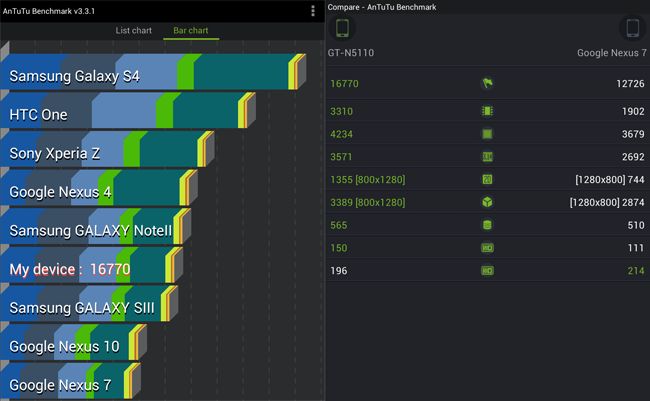
Longer bars are better
As a media player, the Note 8 does an unquestionably fine job. The stereo speakers are much louder and more competent components - there’s a truly impressively amount of bass on offer - than those fitted to either the iPad Mini or the Nexus 7, while both cameras (5Mp at the back, 1.3Mp at the front) perform well by tablet standards even if the main snapper produces rather cold-looking results.
Samsung’s bespoke music and video players also deserve a mention in dispatches. They are not as good as their excellent Sony Xperia equivalents but they are still a great leap forward over the stock software. I particularly like the in-app rotation lock and pop-out player in the video app.
To give you somewhere to stash all your media files, the Note 8 packs 16GB of storage but since ThouchWiz takes an almighty bite out of that it’s just as well that there is also a Micro SD card slot good for cards of up to 64GB.
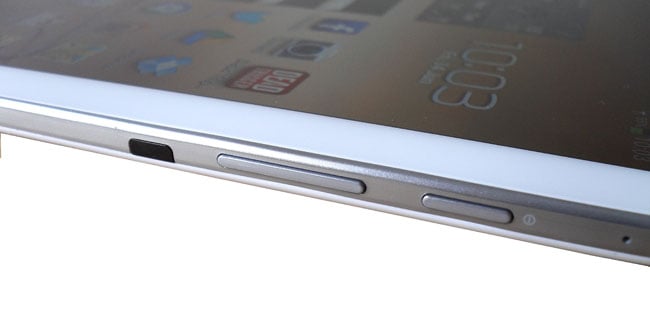
Control your telly with the Note 8’s IR blaster
For connectivity you get dual-band 802.11n Wi-Fi, Bluetooth 4.0 and a micro USB port that supports MHL and On-the-Go hosting. There’s no NFC, but that’s no loss. Arguably of more use is the infra-red transmitter, which lets you use the Note 8 to control your telly. The Peel remote control app comes pre-loaded to take full advantage of the IR blaster.
Thanks to a beefy 4600mAh battery, the 8’s operation life isn’t half bad. Looping a 720p video with the Wi-Fi on and the screen brightness set to Auto, the Note 8 soldiered on to the eight-hour, ten-minute mark before hoisting the white flag. In everyday use you shouldn’t really need to charge it more than once every three or four days.
Incidentally, there is a 3G version of the Note 8, complete with an ear speaker and phone dialer making it a direct competitor to the Asus FonePad. Well, as direct a competitor as something costing around £250 more and being too wide to comfortably hold against your head can be.
The Reg Verdict
In essence, the Note 8 is a Note 2 that’s been handed a jar of steroids before being sent out onto the mean streets of Tabletville to beat the tar out of the iPad Mini, the Amazon Kindle Fire HD and the Nexus 7. Technically, that’s a job it does very well. The only slight fly in the ointment being that the iPad is cheaper, smaller and lighter, though of course it lacks the 8’s GPS radio, S-Pen and storage expansion slot. The first and last are the killers.
The Fire HD 8.9 also lacks many of the Note 8’s key and subsidiary features but at £230 is cheaper still and has a larger, 1920 x 1200, screen. The 16GB Nexus 7 is less than half the price. If the Note 8 included 3G in the £340 asking price - surely not an impossibility if Asus can offer the 3G FonePad for £180 - or was £50 cheaper, it would be an easy recommendation over all the competition, Android and iOS alike, but as it stands the price is perhaps a wee bit high. ®